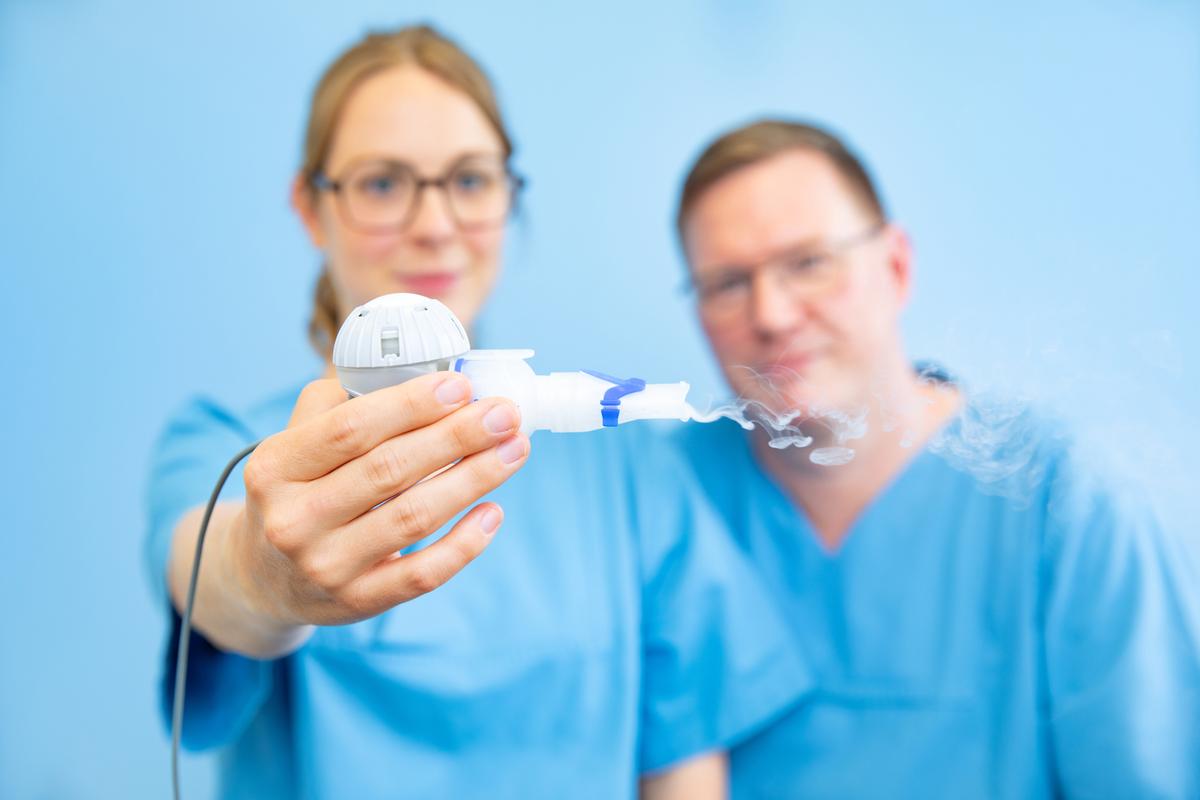MHH study investigates how effective inhalation with hypertonic saline solution is for incurable respiratory disease PCD.

Aiming to bring rapid inhaler and hypertonic saline solution into standard care for PCD patients: Dr Isabell Pink and Professor Dr Felix Ringshausen. Copyright: Karin Kaiser/MHH
In primary ciliary dyskinesia (PCD), our lungs are no longer able to cleanse themselves. The cause is a congenital disorder of the cilia in the bronchi. Similar to cystic fibrosis, this causes thick mucus to accumulate in the airways. People with PCD suffer from chronic bronchitis, pneumonia or enlargement of the lower airways (bronchiectasis) from an early age. There is no cure. PCD is treated with so-called hypertonic saline solution, which has a higher salt content than blood. Inhaled several times a day, it is said to help liquefy the mucus and make it easier to expel or cough up. However, unlike in cystic fibrosis, there is no clinical proof of the effectiveness of this time-consuming treatment. A team led by Professor Dr Felix Ringshausen and Dr Isabell Pink from the Clinic for Pneumology and Infectiology at Hannover Medical School (MHH) now hopes to provide this in cooperation with eight other PCD test centres.
Rapid nebuliser makes inhalation easier
The HELP-PCD study aims to clarify the effect of inhalation with hypertonic, six per cent saline solution compared to inhalation with isotonic, 0.9 per cent saline solution. The researchers are also using a special membrane nebuliser that reduces the inhalation time from 20 to around four minutes. ‘The rapid nebuliser is virtually noiseless, small and mobile, and makes it easier for patients to fit in inhalation into their everyday lives,’ says Professor Ringshausen, Head of the Special Outpatient Clinics for Bronchiectasis Disease, PCD and Cystic Fibrosis. The participants each inhale for eight weeks, first with one saline solution and then with the other, without knowing their concentrations. Their lung function is determined on the one hand using the Lung Clearance Index (LCI), which measures lung ventilation, and on the other hand using imaging techniques such as magnetic resonance imaging (MRI).The German Centre for Lung Research (DZL) is funding the study with around 600,000 euros.
Intervene as early as possible
The disease manifests itself differently depending on age - in children it tends to manifest itself in throat, nose and ear complaints, blocked sinuses or frequent middle ear infections. In adolescents and adults, the build-up of secretions primarily restricts lung function. There are no recovery periods for those affected and they have to take antibiotics to treat the infections or medication to treat the inflammation. By the age of eight, around half of them are already suffering from a pathological widening of the airways as an irreversible consequence of chronic tissue damage. ‘We therefore urgently need to intervene as early as possible to improve the self-cleaning powers of the cilia in the bronchial tubes, prevent the progression of the disease and improve the quality of life of patients,’ says acting senior physician Dr Pink.
But even the diagnosis is not easy. Conventional lung function tests such as spirometry, which only measure the amount of air breathed in and out and the speed of the airflow, are inadequate. X-ray examinations can show the congestion of secretions in the lower lung area that is typical of PCD. However, CT scans, which visualise the lungs in much greater detail, are associated with radiation exposure for patients and are therefore not suitable for assessing the progression of the disease, particularly in young patients. In the HELP study, the researchers therefore want to use a special MRI device that visualises the ventilation and blood flow in the lungs in real time. This is a particularly patient-friendly imaging technique that requires no radiation exposure, no contrast agent and only a few breath-holds.
Bringing the medical device into routine care
While treatment with hypertonic saline solution is covered by statutory health insurance for patients diagnosed with cystic fibrosis, patients with PCD have to pay for the medical device themselves. The necessary inhalation device is also only prescribed on prescription in rare cases, and the health insurance company often refuses to cover the costs. ‘However, PCD sufferers are chronically ill and have to inhale several times a day throughout their lives,’ Professor Ringshausen points out. The study should now provide the necessary proof that the treatment is effective and efficient, especially in combination with the rapid nebuliser, in order to bring the comparatively inexpensive therapy into routine care. ‘We are optimistic that we will succeed,’ emphasises the pneumologist.
The practical implementation of the HELP-PCD study is being carried out with the help of the MHH-based CAPNETZ STIFTUNG in cooperation with the Hannover Unified Biobank of the MHH and the MHH Institute for Diagnostic and Interventional Radiology, as well as other PCD test centres at the university hospitals in Berlin, Bochum, Essen, Giessen, Heidelberg, Kiel, Munich and Münster.
Text: Kirsten Pötzke